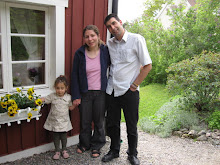




Midsummer
Ask a Swede what the most important holiday of the year is and Midsummer will come up as often as Christmas. Get older Swedes talking and their eyes will well up as they reminisce about community spirit, songs, barn dancing and the mystical atmosphere surrounding the Midsummer gatherings of their youth. Sure, there was a lot of drinking, fistfights and frolicking, but everyone shook hands in the end.
For younger generations, Midsummer is mainly about heading out to the summer cottage and celebrating with a group of friends or family. Midsummer Eve always falls on the third Friday in June so people can enjoy a long weekend or kick off their summer vacation. Celebrations often continue long into Midsummer Day, when people are mainly recovering from the “festivities” of the previous night.
In modern Sweden, Midsummer's Eve and Midsummer's Day (Midsommarafton and Midsommardagen) were formerly celebrated on June 23th and 24th, but since the 1950's on the Friday between June 19th and June 25th and the following Saturday. It is arguably the most important holiday of the year, and one of the most uniquely Swedish in the way it is celebrated, even if it has been influenced by other countries long ago. The main celebrations take place on the Friday, and the traditional events include raising and dancing around a huge maypole. One typical dance is the frog dance. Before the maypole is raised, greens and flowers are collected and used to cover the entire pole.
The start of summer holidays
Summer in Sweden is short. It starts showing its face in May and explodes into life in June. The summer has to hurry to get things done before the nights turn cold in September and everything stops growing. At Midsummer, the Swedish summer is a lush green and bursting with chlorophyll, and the nights are scarcely dark at all. In the north, the sun never sets.
Swedes are fairly well attuned to the rhythms of nature. At Midsummer, many begin their five-week annual holidays and they, too, are in a hurry to get things done. Midsummer Eve is celebrated in the countryside — as always — and on the day before, everyone leaves town, everything closes and the streets are suddenly spookily deserted.
Maypoles and dancing
Midsummer is an occasion of large gatherings — and to be honest, many Swedes take advantage of it to fulfill their social obligations so that they can enjoy the rest of their holiday in peace. In many cases, whole families gather to celebrate this traditional high-point of the summer.
Swedes like the world to be well-ordered, so Midsummer Eve is always a Friday. People often begin the day by picking flowers and making wreaths to place on the maypole, which is a key component in the celebrations.
The maypole is raised in an open spot and traditional ring-dances ensue, to the delight of the children and some of the adults. Teenagers tend to stay out of it and wait for the evening’s more riotous entertainment.
Herring and boiled new potatoes
A typical Midsummer menu features different kinds of pickled herring, boiled new potatoes with fresh dill, soured cream and raw red onion. This is often followed by a grilled dish of some kind, such as spare rib or salmon, and for dessert the first strawberries of summer, with cream.
The traditional accompaniment is a cold beer and schnapps, preferably spiced. Every time the glasses are refilled, singing breaks out anew. Swedes like drinking songs and the racier the better.
Mysterious Midsummer
On their way home, girls and young women are supposed to pick seven different species of flowers and lay them under their pillows. At night, their future husbands appear to them in a dream.
Legend has it that the night before Midsummer’s Day is a magical time for love. It still is, in a way. During this night a relationship is put to the test. Under the influence of alcohol, the truth will come out; this can lead both to marriage and to divorce.
Also, Midsummer is associated with magic and fertility rites. The Midsummer maypole, a fertility symbol used to “impregnate” Mother Nature, was meant to bring a good autumn harvest.
How we celebrate
Well, as good “adopted” Swedes, we will start our day going shopping ( we buy things for the grill and drinks of course), then we go in Smedjebacken to see how people celebrate and be part of it. We are going to meet Linda and her children, close to BuBu´s age, and we have the party itself at Ann-Sofie’s house (where I lived for two weeks when I was here in January).
It will be fun to be out, with so many friends, good mood and happy spirit. And the good thing is it does not end in the same day, we have a little vacation till Monday, so 3 days to celebrate and enjoy summer in Sweden.

No comments:
Post a Comment